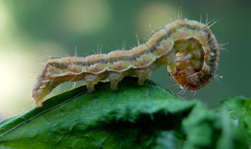Helicoverpa Armigera (African Bollworm) Caterpillars in Flowers
 Caterpillars are seasonal pests to the flowers but when in season result in major losses to the flower industry as one caterpillar can cause damage to more than one flower. In flowers there are different kinds of caterpillar species which include helicoverpa armigera and spodopteraexigua and thus it’s important to know the exact pest that one has in their crop and out of these two, the helicoverpa species is the notorious and listed as a notifiable pest in the European market.
Caterpillars are seasonal pests to the flowers but when in season result in major losses to the flower industry as one caterpillar can cause damage to more than one flower. In flowers there are different kinds of caterpillar species which include helicoverpa armigera and spodopteraexigua and thus it’s important to know the exact pest that one has in their crop and out of these two, the helicoverpa species is the notorious and listed as a notifiable pest in the European market.
Description
Helicoverpa armigera commonly known as African bollworm is the main caterpillar that infests flowers in green houses and outdoor ones. It is a pest of roses, carnations, hypericum, gypsophilla amongst other flowers. It is a moth with the larval stages referred to as caterpillar being the destructive stage. It is unique in that the moth lays its eggs singly on the roses and specifically on the softest parts of the crop. In roses the eggs are found on the flower buds and petals. The eggs are small, yellowish-white, ribbed and rather dome shaped. The egg period is two days after which it hatches to a larva- the caterpillar. The caterpillar eats the eggshell to emerge after which it bolls making circular holes through the petals only to feed from inside the flower. The color of the African bollworm caterpillar varies from green to reddish brown; has three dark stripes that extend along the dorsal side and one yellow light stripe situated under the spiracles on the lateral side. When the caterpillar is disturbed, it lifts its head and curls it under the front of the body. If even more disturbed, it lets go and drops, rolling into a spiral. There are 6 instars or stages of the caterpillar in a larval period of 16 days and the damage to the crop increases with increase in size of the caterpillar. These caterpillars are cannibalistic. When a caterpillar matures it drops into the soil or the growth media to pupate. The pupa is shiny brown; about 16mm long with smooth surface and with two short parallel spines at the posterior tip of the body and the pupal period is 10 days at normal temperatures. The pupa is dormant and doesn’t feed.
When it rains the pupa emerges into an adult called moth with the male moths being greenish in color and females being brownish. Generally the adult moth is fleshy, yellowishbrown with a dark speck, greyish irregular lines and a black kidney-shaped mark on the forewings. The hind wings are whitish with a black patch along the outer margin. The moth is about 14 to 18mm long with a wingspan of 35 to 40mm.The moths are nocturnal and thus not easily seen unless one has a trapping system like pheromone traps specifically for the helicoverpa or light traps or water traps. One female moth can lay around 3000 eggs in a lifespan of 10 days and thus one moth can cause an economically reputable damage to one greenhouse. These moths lay eggs closely soon after the rains start and thus its important to have an alert scouting system.
Why it’s a challenge
The fact that the moth is nocturnal and its presence is mostly recognised by the presence of eggs on the flowers or live caterpillars on the flowers is a challenge.There is also insufficient knowlede of this pest as most people just associate the caterpillars to presence of butterflies they see around during the rainy season.Others kill the eggs by physically crushing them which leaves a chance of some hatching unnoticed and causing damage to the flowers.There is also a recorded incidence of this caterpillar having resistance to chemicals and some of these chemicals are expensive leading to increased cost of production. A pest can be well managed when its lifecycle is known and when the destructive stage is identified and controlled at the right time before the thresholds are reached. Its recommended to apply effective scouting methods like use of traps like pheromone, water or light traps as a an early warning system.
Pest management
Caterpillars on roses and other crops have been and still are most commonly treated with synthetic chemical insecticides. While synthetic chemical insecticides have provided effective ways to protect crops, their indiscriminate use has abused them. Other means of crop protection, such as biological and microbial control, are being used to a much lesser extent, although there are many examples of highly successful use of predators and parasites.


